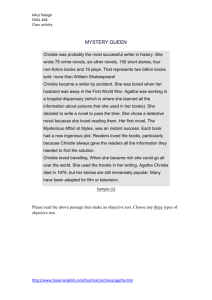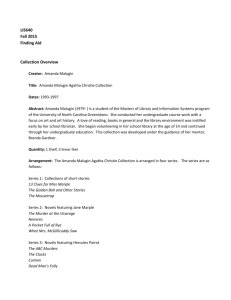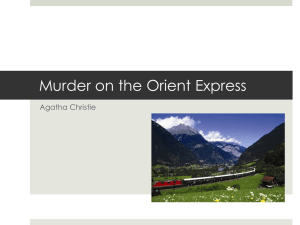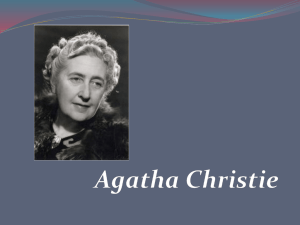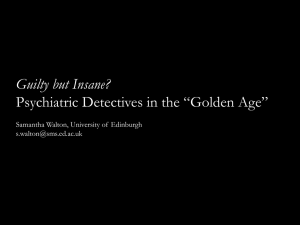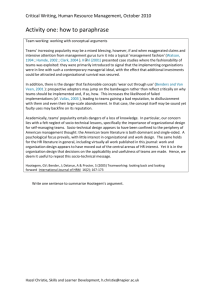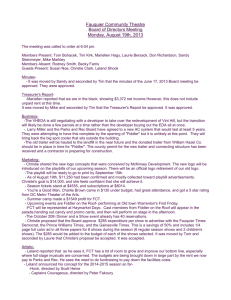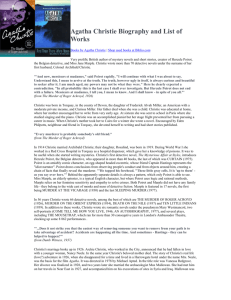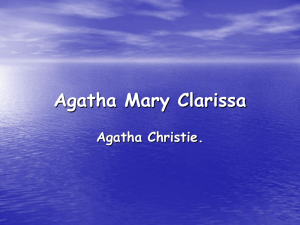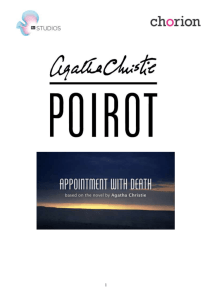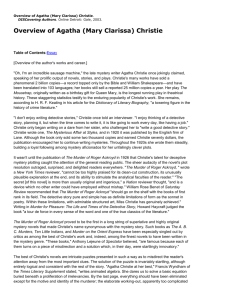Agatha Christie: Successful Travelling Woman Writer
advertisement
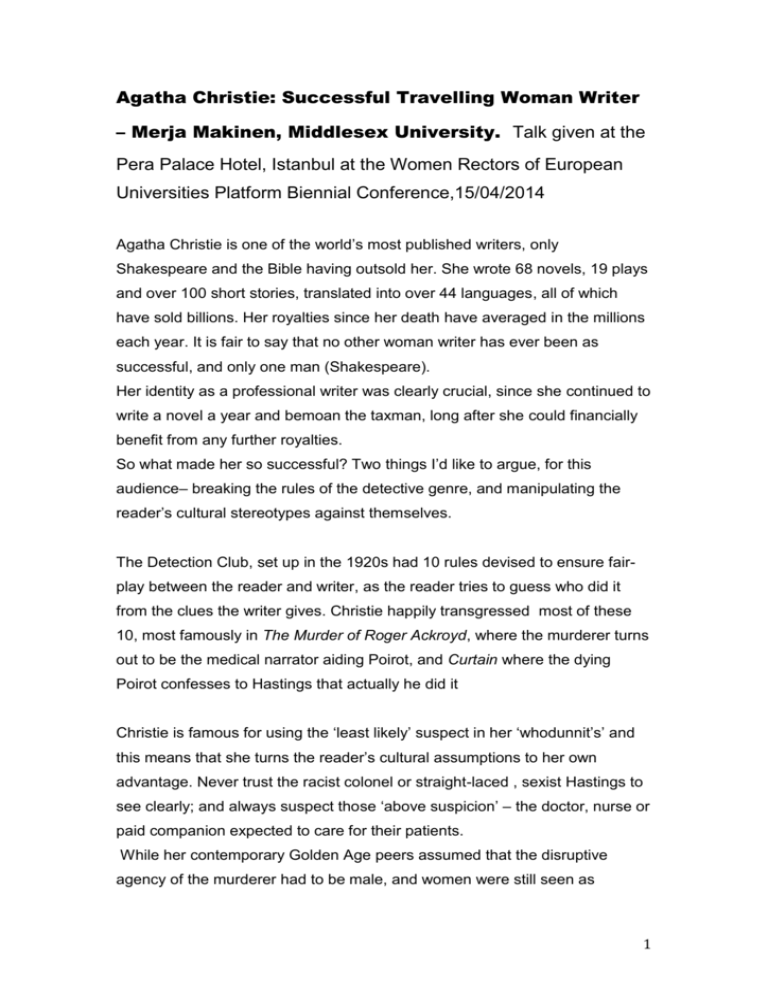
Agatha Christie: Successful Travelling Woman Writer – Merja Makinen, Middlesex University. Talk given at the Pera Palace Hotel, Istanbul at the Women Rectors of European Universities Platform Biennial Conference,15/04/2014 Agatha Christie is one of the world’s most published writers, only Shakespeare and the Bible having outsold her. She wrote 68 novels, 19 plays and over 100 short stories, translated into over 44 languages, all of which have sold billions. Her royalties since her death have averaged in the millions each year. It is fair to say that no other woman writer has ever been as successful, and only one man (Shakespeare). Her identity as a professional writer was clearly crucial, since she continued to write a novel a year and bemoan the taxman, long after she could financially benefit from any further royalties. So what made her so successful? Two things I’d like to argue, for this audience– breaking the rules of the detective genre, and manipulating the reader’s cultural stereotypes against themselves. The Detection Club, set up in the 1920s had 10 rules devised to ensure fairplay between the reader and writer, as the reader tries to guess who did it from the clues the writer gives. Christie happily transgressed most of these 10, most famously in The Murder of Roger Ackroyd, where the murderer turns out to be the medical narrator aiding Poirot, and Curtain where the dying Poirot confesses to Hastings that actually he did it Christie is famous for using the ‘least likely’ suspect in her ‘whodunnit’s’ and this means that she turns the reader’s cultural assumptions to her own advantage. Never trust the racist colonel or straight-laced , sexist Hastings to see clearly; and always suspect those ‘above suspicion’ – the doctor, nurse or paid companion expected to care for their patients. While her contemporary Golden Age peers assumed that the disruptive agency of the murderer had to be male, and women were still seen as 1 second-class citizens, Christie treated cultural agency in terms of equality and just as many of her villains are women as men. So woe betide the reader who holds sexist assumptions, they’ll never guess who did it. Indeed, she has one of her detective’s berate himself for his own sexism when he realises that the elderly, genteel Miss Marple figure, who has helped him sleuth, is in fact a highly successful serial killer apprehended during her eighth murder: ‘Not a man – you assumed it was a man… but she never said so.’ (Murder is Easy, p.215). Christie’s texts indict conventional beliefs as being foolish stereotypes that prevent us seeing the complex truth. So one key to success, I’d like to argue, that Christie as a writer can teach us is to refute laid down cultural conventions – and quietly break the boundaries. Her biography is of a similarly quiet rejection of the norm. Christie was a successful woman writer at a time when writing was still seen as a male profession, her first novel, The Mysterious Affair at Styles, was published in 1920, but it wasn’t until her husband’s leaving her in 1926 that she considered herself a professional writer, looking to the books to support her single-parent family. Once she has seen her daughter happily settled in a good boarding school, she booked a conventional trip to Jamaica with Cook’s travel. Two days before leaving, she had dinner with a couple who had lived in Baghdad and inspired by their enthusiasm, and the fact that she could travel there on the Orient Express to Stamboul, and then on to Damascus and Baghdad, she changed her plans on a whim. Her wild excitement, rejected the wiser counsel of 1928,’ All by yourself to the Middle East? You don’t know anything about it’ with the response, ‘After all, one must do things for oneself some time, mustn’t one?...It’s now or never. Either I cling to everything that’s safe and that I know, or else I develop more initiative to do things on my own.’ (Autobiography, p.372) and she boards the Simplon Express in the spirit of a thirty year old woman in search of adventure and self-discovery. Settled in the Tokatlian hotel she is shown the sights of Istanbul by a Dutch engineer who takes her under his wing. Taken across the Bosphorus to rejoin the train at Haidar Pasha. On the second day, the train stopped to allow the travellers to view the Cilician Gates, as the sun set, a moment of incredible beauty that 2 she never forgot. ‘I was so glad then that I had come- so full of thankfulness and joy.’ (Autobiography, p. 378) This view she named the most beautiful experience of her life, ‘It is like standing on the rim of the world and looking down on the promised land.’ (Come Tell Me How You Live, p. 31) Resuming the journey, Christie arrived in Baghdad and visited the dig at Ur. Returning the following season, she met her second husband, the archaeologist Max Mallowan, who was significantly younger than herself. The next thirty years were spent on digs in Syria and Iraq, as well as in Cornwall, and they owned a house in Baghdad either side of the Second World War. When not writing, Agatha washed and labelled the finds and dolled out aspirins or laxatives to the local sheiks’ wives. Biographically as well as authorially, Agatha Christie found emotional happiness from doing the unexpected and pursuing a course she felt would allow her to fulfil her own self, however unconventional. One of the most important Christie words in her work is ‘risk’ – one has to take risks in order to achieve great results. Turning to the Novels: Cat Among the Pigeons 1959 Cat among the pigeon deals with women and education and so seems ideal for such a gathering. It is set in an exclusive girl’s boarding school, where all the characters are career women. The narrative starts in a fictional Middle Eastern state of Ramat, where the sheikh gives his British friend his fabulous bag of diamonds to get abroad before the political uprising catches up with him. Hiding them in his niece’s tennis racquet handle, both the friend and the sheikh are killed when their escaping plane is blown up. The niece and her racquet return to England and the exclusive girl’s school of Meadowbanks, where a series of spies infiltrate to try and find the diamonds. Three murders and a kidnapping or two later, Poirot unveils the whole nest of plots and unmasks the villains. For our purposes, I want to focus on 4 female characters, who demonstrate Christie’s creation of admirable and complex women: the headmistress, Miss Bulstrode and her efficient secretary Ann Shapland celebrate the excitement 3 of independent working women, and the Upjohn mother and daughter demonstrate a female adventurousness alongside intelligence and bravery. Miss Bulstrode has created the school out of her own vision and passion, and has made it one of the most successful schools in the country. She is portrayed as an elderly but vigorous personage, indomitable and perceptive, who can see through most people. Her work as a headmistress is depicted as exciting and fulfilling: During her career as a headmistress, she herself had never felt dull. There had been difficulties to combat, unforeseen crises, irritations with parents, with children: domestic upheavals. She had met and dealt with incipient disasters and turned them into triumphs. It had all been stimulating, exciting, supremely worthwhile. (Cat Among the Pigeons, p. 98) It is an extraordinarily dynamic and exciting portrayal of educational administration – and one I hope we all share in 2014 – and as usual celebrates the risks and the battles of refusing to accept the norm but creating an innovative academic institution. Pp. 10 ‘I took chances. I upset a lot of people I bullied and cajoled, and refused to follow the pattern of other schools.’ (Cat Among the Pigeons p.103) Miss Bulstrode had enjoyed the adventure, the hazard of it all…uninterested in safety. She had had her vision of what a school should be and she had pursued it unafraid. And she had been justified in her audacity.[ …] Meadowbanks was established [..,] as a great English institution’ (Cat Among the Pigeons, p.206) Look at this positioning of women running education in the nineteen fifties, with verbs of bravery and battle: combat, incipient disasters turned to triumphs, rejections of safety, audacity, and alongside the celebration of the risks, the hazards, the chances, its worth: supremely worthwhile, - justified - a great institution. It’s a representation I think to inspire us all. Ann Shapland, Miss Bulstrode’s secretary, cool efficient and excellent at her job, enjoys the variety of posts available to the good secretary – from an 4 archaelogist, to an oil tycoon to an actress, and now a school. Work is of more interest to this beautiful woman than marriage. But Ann is unveiled as not only the attractive efficient secretary but also an effective professional killer from the age of 17, one of the most dangerous agents of the last war with a code name of Angelica and responsible for two of the murders. Ann is unveiled by Mrs Upjohn, a sensible mother who having served in the Military Intelligence during the war, is now adventurously travelling round the interior of Turkey, reflecting much of Christie’s own travels in the ‘Near East’. The insular and patriarchal detectives searching for her, are shocked to find that she is not on a safe package tour but is independently travelling in Anatolia on local transport – the very thing Agatha did on her first adventure alone. Starting in Stamboul, then on to Ankara, and ending up in Van in three or so weeks time. The consulate tracks her down beside the bus, picnicking with her Turkish friends and content with her adventure: Mrs Upjohn had lost complete count of time. Floods had blocked two of the roads, detours had been necessary and they had once been stuck for seven hours until the river they were fording had subsided. Ankara lay in the not impossible future and that was all she knew. Cat Among the Pigeons, p.304) In her Autobiography, Christie stated that when the train left Haida Pasha, ‘There was a subtle difference on passing from Europe to Asia. It was as if time had less meaning.’(Cat Among the Pigeons, p.377) and this is, as Julia Upjohn explains, the experience that her mother enjoys in going to Anatolia on a bus. Everyone, from Miss Bulstrode, to the consulate official agree that Mrs Upjohn is ‘a very sensible woman’ who acts without fuss and unveils the main murderer. And so the adventure of independent travel becomes available for the woman reader. Her young daughter, Julia, just starting at Meadowbanks, is the character who actually works out the mystery and discovers the diamonds hiding place, and having barricaded herself in her bedroom overnight against the murderer, sensibly takes them to Poirot, as the safest thing to do. The young girl’s intelligence resolves the mystery and begins the solution to the crimes. An adventurous headmistress, an adventurous woman traveller, an efficient secretary and double agent and an intrepid, intelligent young girl – Cat 5 amongst the Pigeons creates a whole range of successful and available femininities for the women readers of the late nineteen fifty’s to the present day and I hope that revealing who did some of it will not prevent your reading it on your return. Murder on the Orient Express 1934 Set on the train that first brought Agatha to Istanbul, the train that spelled adventure: ‘All my life I had wanted to go on the Orient Express. When I had travelled to France or Spain or Italy, the Orient Express had often been standing at Calais, and I had longed to climb up into it. Simplon-Orient Express – Milan, Belgrade, Stamboul..’ (Autobiography p.372) and deemed her favourite train of all time. The book is believed to have been partially written in this hotel, Pera Palace. Here too we have a range of interesting and successful women from the Princess Dragomiroff, the brilliant actress Linda Arden, masquerading as the annoying Mrs Hubbard, the efficient secretarial teacher Mary Debenham and the beautiful Countess Andreyani, among others. But the real interest in this novel, I think, apart from its starting from Istanboul and the brief amusing discussion around the viewing and reputation of ‘La Sainte Sophie’ is the issue of the crime and its solution. Because, where as in Cat Among the Pigeons there is a conventional mystery and resolution, with one main villain apprehended and the reader given all the information and a decent chance of guessing whodunit. In Murder on the Orient Express, Christie again breaks, or at least bends out of recognition, the rules. Like Miss Bulstrode, she refused to ‘follow the pattern’ of other detective plots, and of the 12 suspects in the locked railway carriage – they all turn out to be the murderer. The plot centres on an actual crime of the kidnapping of the young daughter of a celebrated American family, who was killed despite the paying of the ransom. In Christie’s novel, the young girl is Daisy Armstrong, and the crime destroys her parents and a maid who came under suspicion. The twelve strangers in the carriage are unmasked by Poirot as the remaining family of Daisy, the father of the maid, and various servants and friends. These twelve, imitating 6 the twelve members of a British jury, execute the kidnapper who has escaped American justice through police corruption. In a drugged sleep, he is stabbed by each of them in turn, so that none can know who inflicts the killer blow, but all are implicated. What is the famous detective Hercules Poirot’s solution, once he has unmasked the plot and the crime? Why to offer two alternate solutions, one the real events, the other the fiction of a stranger masquerading as a railway official who escapes the train before the murder is discovered. Not only then does Christie bend the rules in having everybody be the murderer, but she also lets them all go free! Poirot perceives the unlawful killing as a form of rough justice and the real villain as the murdered victim who ruined five people’s lives through his callous action. This is a crime novel where everyone did it and no one is punished except the victim. It is an audacious refusal to play by the rules and follow the pattern of the usual detective novel. And because of that, it is one of her most successful and well known, the world over. So how do I bring to a conclusion this journey through Christie’s life and work? That huge success comes from celebrating the strengths and variation of women’s exuberance, intelligence and effort; an injunction perhaps, never to accept expectations and stereotypes of how things should be done, but audaciously look for the right answers or visions, bending the rules when necessary; and perhaps lastly, to enjoy the adventure of travel and companionship here at the gateway between Europe and the ‘Near East’. Bibliography: Autobiography, (London: Fontana/Collins, 1978) Cat Among the Pigeons, (London: HarperCollins, 2002) Come, Tell Me How You Live, (London: HarperCollins, 1999) Murder is Easy, (London: HarperCollins, 1993) Murder on the Orient Express, (London: HarperCollins, 1994) m.makinen@mdx.ac.uk 7
